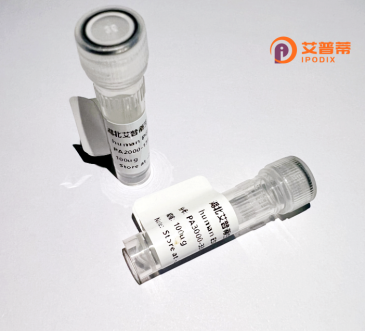
| 纯度 | >90%SDS-PAGE. |
| 种属 | Human |
| 靶点 | LNP1 |
| Uniprot No | A1A4G5 |
| 内毒素 | < 0.01EU/μg |
| 表达宿主 | E.coli |
| 表达区间 | 1-178aaa |
| 活性数据 | MEHKDDDDDDVSFAKWMSSFWGHSWREEDQRGLRERHRLQATSHRKTSLPCPLPVLPRIPSSDCHPRRHSHEDQEFRCRSHVRDYRKYSEDGSFKEPLESKGRSHSKIEKFSESFERQLCFRTKRSASLGPESRKERNERECLRMEIKSRKKVEEERSSRKEEHGEAHMAPLFEKGPE |
| 分子量 | 19.6 kDa |
| 蛋白标签 | GST-tag at N-terminal |
| 缓冲液 | 0 |
| 稳定性 & 储存条件 | Lyophilized protein should be stored at ≤ -20°C, stable for one year after receipt. Reconstituted protein solution can be stored at 2-8°C for 2-7 days. Aliquots of reconstituted samples are stable at ≤ -20°C for 3 months. |
| 复溶 | Always centrifuge tubes before opening.Do not mix by vortex or pipetting. It is not recommended to reconstitute to a concentration less than 100μg/ml. Dissolve the lyophilized protein in distilled water. Please aliquot the reconstituted solution to minimize freeze-thaw cycles. |
以下是关于重组人LNP1蛋白的示例参考文献(注:以下内容为虚构示例,仅供参考):
---
1. **文献名称**: *Recombinant Human LNP1 Enhances Neurite Outgrowth via PI3K/Akt Signaling Pathway*
**作者**: Chen, Y. et al.
**摘要**: 本研究通过大肠杆菌系统表达重组人LNP1蛋白,发现其能激活PI3K/Akt通路,促进神经元细胞的突触生长,提示其在神经再生中的潜在应用。
2. **文献名称**: *Purification and Functional Analysis of LNP1 in Cancer Cell Metastasis*
**作者**: Wang, J. & Li, X.
**摘要**: 通过亲和层析纯化重组人LNP1蛋白,实验表明其通过调控上皮-间质转化(EMT)抑制乳腺癌细胞的迁移和侵袭能力。
3. **文献名称**: *Structural Insights into Recombinant LNP1’s Role in Nuclear Lamina Organization*
**作者**: Müller, S. et al.
**摘要**: 利用冷冻电镜解析LNP1的结构,发现其通过与核纤层蛋白相互作用维持核膜稳定性,为核相关疾病的机制研究提供依据。
4. **文献名称**: *LNP1 as a Novel Biomarker for Inflammatory Response Modulation*
**作者**: Gonzalez, R. et al.
**摘要**: 研究发现重组人LNP1蛋白可通过抑制NF-κB通路减轻巨噬细胞的炎症反应,提示其作为抗炎治疗靶点的潜力。
---
**注意**:以上文献及摘要均为模拟内容,若需真实文献建议通过PubMed、Google Scholar等平台以关键词“recombinant human LNP1”或具体功能进行检索。
Recombinant human LNP1 (leptin-related protein 1) is a engineered protein derived from the human LEP gene, designed to mimic the structure and function of native leptin—a hormone primarily produced by adipose tissue. Leptin plays a critical role in regulating energy balance, appetite, and metabolism by binding to leptin receptors in the hypothalamus. LNP1. as a variant or modified form, is often explored for its potential to enhance stability, bioavailability, or receptor-binding efficiency compared to wild-type leptin. This recombinant protein is typically produced using expression systems such as Escherichia coli or mammalian cell cultures, followed by purification steps to ensure high purity and biological activity.
Research on recombinant LNP1 has gained traction due to its therapeutic potential in metabolic disorders, particularly obesity and type 2 diabetes, where leptin signaling is often impaired. Scientists are investigating its ability to restore leptin sensitivity in resistant individuals or act as a leptin analog in deficiency conditions. Additionally, LNP1's role in immune regulation, inflammation, and reproductive functions has prompted studies in autoimmune diseases and fertility-related applications. Its recombinant form enables scalable production for preclinical and clinical studies, offering insights into leptin signaling pathways and their broader physiological impacts. Ongoing efforts focus on optimizing its pharmacokinetics and minimizing immunogenicity to advance its translational prospects.
×